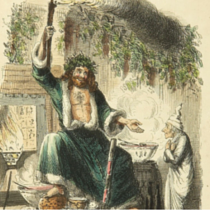“What?” You say. Christmas? But, but, but… Christmas is jolly. Christmas is dollies. Christmas is holly. Christmas is… other things ending in “olly.” Isn’t it?
We have Mr. Clement Clarke Moore to thank for this deeply rooted—in America, at least—vision of Christmas. He wrote “A Visit from St. Nicholas” for his nine children and read it to them every year on Christmas Eve. The poem was published anonymously in 1823 and gained a lot of traction – it has never gone out of print and is embedded in the American psyche. If you don’t recognize the author or the title, here are just a few lines:
‘Twas the night before Christmas, when all through the house
Not a creature was stirring, not even a mouse
Most of us have either read or heard the rest of the poem, which may be read in full here. But the imagery! St. Nicholas comes in a sleigh drawn by eight tiny reindeer (this is first time they are named: Dasher, Dancer, Prancer, Vixen, Comet, Cupid, Donner and Blitzen), and comes bearing gifts of toys. A brief excerpt of how he’s described is as follows:
He had a broad face and a little round belly
That shook when he laughed, like a bowl full of jelly.
He was chubby and plump, a right jolly old elf.
That IS Santa Claus, isn’t it?
A couple of years before this famous poem he wrote another called Old Santeclaus. Here is an excerpt:
But where I found the children naughty,
In manners rude, in temper haughty,
Thankless to parents, liars, swearers,
Boxers, or cheats, or base tale-bearers,
I left a long, black, birchen rod,
Such as the dread command of God
Directs a Parent’s hand to use
When virtue’s path his sons refuse.
It didn’t have the same joie de vivre as “A Visit from St. Nicholas” and, fortunately, faded away.
Dickens’ novella “A Christmas Carol,” written just twenty years later, albeit in England, is a lot darker in spirit (pardon the pun) than “A Visit from St. Nicholas” and doesn’t involve St. Nicholas by name. The closest character in the story to even approach the persona of old St. Nick is The Ghost of Christmas Present, who whisks Scrooge around to view the state of the world in that exact moment, much as George Bailey is whisked about by Clarence—the angel who wants his wings in It’s A Wonderful Life. But Scrooge is seeing the present as it is, while George is seeing an altered future; one without him. All of Dickens’s spirits are those of chaos and Clarence represents chaos too; these spirits turn everything on its head showing us a topsy-turvy version of the world.
But that’s what the Christmas tradition once was—it was misrule, revelry and debauchery. The tradition draws from the Roman celebration of Saturnalia where roles were reversed: master waited on servant, sacrifices to the gods and feasting were celebrated, and gifts given as tokens of esteem. The revelries of Saturnalia were supposed to represent a lost and idealized mythical age. Saturnalia as this kind of celebration died out in the early Christian era, but many of the traditions carried over to the medieval and modern eras although in different forms. In England up through the 18th century, and perhaps a bit beyond, those who had wealth and fortune were expected to open their doors and feast those less fortunate than they during the yuletide season.
The Puritans REALLY didn’t like the idea of Christmas and the misrule that accompanied it. In fact, they officially banned the observance of Christmas in England for about twenty years until it, along with the monarch Charles II, was restored in 1660. The observance of Christmas was quashed in New England for a good deal longer, and in 1659 in the Massachusetts Bay Colony fines were meted out to people celebrating Christmas in any way, shape or form. No revelries allowed. Only work was acceptable. (With many thanks to Stephen Nissenbaum’s The Battle for Christmas for these insights and references.)
Whew! Thank goodness we’ve turned the corner on that! Revelries abound and whether or not you celebrate Christmas, we can take a guilt-free couple of days off and enjoy the turn of the year.
So, let’s close with a wassail song:
Here we come a wassailing
Among the leaves so green,
Here we come a wandering
So fair to be seen.
Chorus
Love and joy come to you,
And to you your wassail too,
And God bless you and send you a happy New Year.
And God send you a happy New Year.
Other Resources:
New York Today: A Little History of Christmas
Bethlehem, CT – Connecticut’s Christmas Town
Sending Season’s Greetings: Christmas Cards in Connecticut
O Christmas Tree!
Quiz: Christmastime in Connecticut









